
The brown hairstreak is a butterfly in the family Lycaenidae. The range includes most of the Palaearctic.

Lycaena phlaeas, the small copper, American copper, or common copper, is a butterfly of the Lycaenids or gossamer-winged butterfly family. According to Guppy and Shepard (2001), its specific name phlaeas is said to be derived either from the Greek φλέγω (phlégo), "to burn up", or from the Latin floreo, "to flourish".

The holly blue is a butterfly that belongs to the lycaenids or blues family and is native to the Palearctic.
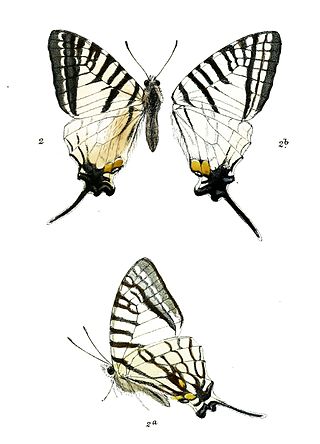
Graphium eurous, the sixbar swordtail, is a swallowtail butterfly belonging to the genus Graphium, also known as the swordtails.

Parnassius delphius, the banded Apollo, is a high-altitude butterfly which is found in Central Asia. It is a member of the genus Parnassius of the swallowtail family, Papilionidae.

Parnassius actius, also known as the scarce red apollo, is a high-altitude butterfly found in Central Asia. It is a member of the snow Apollo genus (Parnassius) of the swallowtail family (Papilionidae).

Acropolis is a monotypic butterfly genus from the subfamily Satyrinae in the family Nymphalidae. The one species in the genus, Acropolis thalia, is distributed in western subtropical China. The genus was erected by Francis Hemming in 1934 based on a species described by John Henry Leech in 1891.

Lycaena thetis, the golden copper, is a small butterfly found in Greece, Asia Minor - Armenia (highlands), Iraq, Iran, Baluchistan, Chitral and Ladak that belongs to the lycaenids or blues family.

Jamides caerulea, the royal cerulean, is a small butterfly that belongs to the lycaenids or blues family. It was described by Herbert Druce in 1873. It is found in the Indomalayan realm.
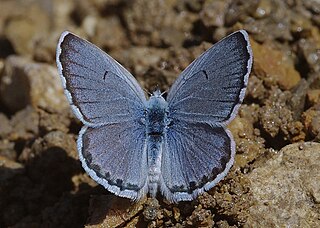
Pseudophilotes vicrama, the eastern baton blue, is a small butterfly found in Asia, east to Tian Shan and parts of China, west to the Balkans, Turkey, eastern Europe to southern Finland. It belongs to the lycaenids or blues family. The species was first described by Frederic Moore in 1865.

Friedrich Joseph Adalbert Seitz, was a German physician and entomologist who specialised in Lepidoptera. He was a director of the Frankfurt zoo from 1893 to 1908 and is best known for editing the multivolume reference on the butterflies and larger moths of the world Die Gross-Schmetterlinge der Erde which continued after his death.

Arhopala silhetensis, the Sylhet oakblue, is a small butterfly found in India that belongs to the lycaenids or blues family. The species was first described by William Chapman Hewitson in 1862.
Arhopala aedias yendava, the Singapore oakblue, is a subspecies of Arhopala aedias a small butterfly found in India that belongs to the lycaenids or blues family.
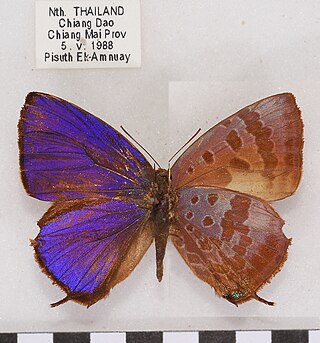
Arhopala agaba, the purple-glazed oakblue, is a small butterfly found from India to Thailand, Langkawi, Indochina, Peninsular Malaysia to the Philippines and Sumatra that belongs to the lycaenids or blues family. The species was first described by William Chapman Hewitson in 1862.

Flos areste, the tailless plushblue, is a small butterfly found in the Indomalayan region that belongs to the lycaenids or blues family.
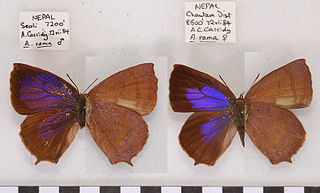
Arhopala rama, the dark Himalayan oakblue, is a small butterfly found in India, Indochina, China and Japan that belongs to the lycaenids or blues family.
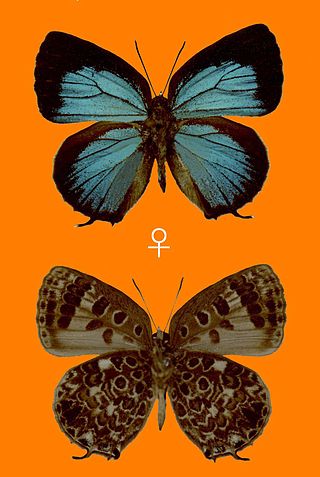
Arhopala alesia, the pallid oakblue, is a small butterfly found in India that belongs to the lycaenids or blues family.

Lysandra albicans, the Spanish chalk-hill blue, is a butterfly of the family Lycaenidae. It is found in Spain and Western North Africa.

Dilipa fenestra is a butterfly found in the East Palearctic that belongs to the browns family.
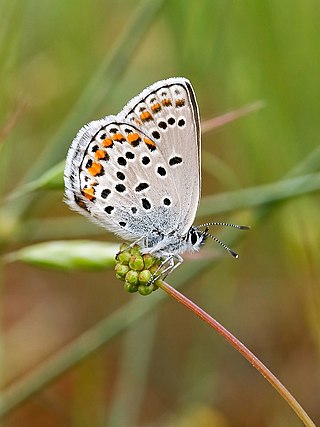
Kretania sephirus, previously known as Plebejus sephirus, is a species of butterfly that belongs to the family Lycaenidae. It is found in Eastern Europe, the Caucasus, and Asia Minor. The species is part of a species complex, with many members of the complex using variations of the name zephyr blue, including pylaon, trappi, and hesperica. The species, which previously belonged to the genus Plebejus, was moved to the genus Kretania following a 2013 molecular phylogenetics study of the subtribe Polyommatina. Many sephirus populations are threatened, and are legally protected in some countries, such as Hungary.



















